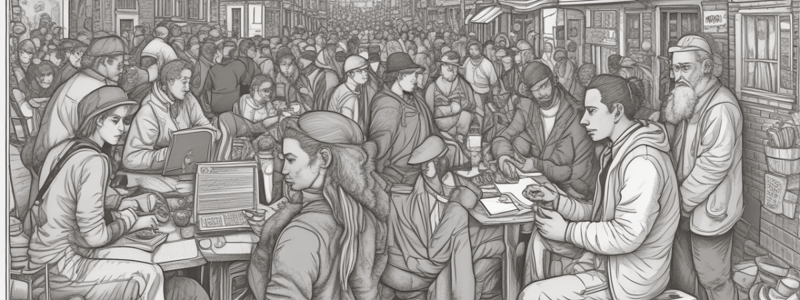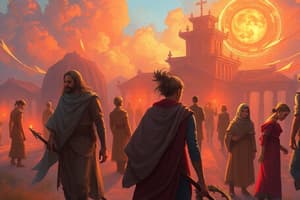Podcast
Questions and Answers
What is the definition of a gang according to the Neighborhood Assessment Form?
What is the definition of a gang according to the Neighborhood Assessment Form?
- A group of people who have a common interest in sports
- A group of friends who live in the same neighborhood
- A group of three or more persons who have a common hobby
- An ongoing, organized association of three or more persons who have a common name or common signs, colors, or symbols and members or associates who individually or collectively engage in or have engaged in criminal activity (correct)
When did gangs, as we know them today, start to form in the United States?
When did gangs, as we know them today, start to form in the United States?
- 1920's (correct)
- 1800's
- 1950's
- 1970's
What was the characteristic of gangs in the 1920's?
What was the characteristic of gangs in the 1920's?
- They were formed around neighborhoods as small as one city block
- They were known for their charitable work
- They were made up of family members and friends (correct)
- They were mostly involved in organized crime
What happened to gangs in the 1950's?
What happened to gangs in the 1950's?
What was a distinctive feature of gangs in the 1950's?
What was a distinctive feature of gangs in the 1950's?
What was the nature of conflicts between gangs in the 1950's?
What was the nature of conflicts between gangs in the 1950's?
Where are gangs most often located?
Where are gangs most often located?
What is the primary reason for the decrease in gang activity in the 1960s?
What is the primary reason for the decrease in gang activity in the 1960s?
What type of gang members are heavily involved in criminal activities but are 'followers'?
What type of gang members are heavily involved in criminal activities but are 'followers'?
What is a common sideline activity for gangs?
What is a common sideline activity for gangs?
What is unique about the demographic makeup of modern gangs?
What is unique about the demographic makeup of modern gangs?
What is a characteristic of 'Wanna-be' gang members?
What is a characteristic of 'Wanna-be' gang members?
What is a common source of income for gangs?
What is a common source of income for gangs?
What is a reason for the evolution of gangs into mixed groups?
What is a reason for the evolution of gangs into mixed groups?
What percentage of gangs are 'party gangs'?
What percentage of gangs are 'party gangs'?
What is a characteristic of 'hard-core' gang members?
What is a characteristic of 'hard-core' gang members?
What is a characteristic of hate groups?
What is a characteristic of hate groups?
What is the goal of political groups like ALF?
What is the goal of political groups like ALF?
What is a characteristic of terrorist groups?
What is a characteristic of terrorist groups?
What is a characteristic of ethnic gangs?
What is a characteristic of ethnic gangs?
What is a characteristic of transient groups, such as Gypsies?
What is a characteristic of transient groups, such as Gypsies?
What type of criminal activities do some Gypsies participate in?
What type of criminal activities do some Gypsies participate in?
What is one reason why people who move from cities to suburban areas may still experience gang problems?
What is one reason why people who move from cities to suburban areas may still experience gang problems?
What are the three social needs that are often unmet in gang members?
What are the three social needs that are often unmet in gang members?
What is one way that law enforcement can attempt to curb gang activity?
What is one way that law enforcement can attempt to curb gang activity?
What is one trait of young people who are at risk of joining gangs?
What is one trait of young people who are at risk of joining gangs?
What is the name of the two "Nations" that most street gangs line up under?
What is the name of the two "Nations" that most street gangs line up under?
What is one indicator of possible gang involvement?
What is one indicator of possible gang involvement?
What is one thing that the community can do to attempt to curb gang activity?
What is one thing that the community can do to attempt to curb gang activity?
What is the term for the smaller groups within a larger gang?
What is the term for the smaller groups within a larger gang?
What is the term for the newspaper of gangs?
What is the term for the newspaper of gangs?
What is one reason why many gang members come from dysfunctional families?
What is one reason why many gang members come from dysfunctional families?
Flashcards are hidden until you start studying
Study Notes
Definition of a Gang
- A gang is an ongoing, organized association of three or more persons, whether formal or informal, who have a common name or common signs, colors, or symbols and members or associates who individually or collectively engage in or have engaged in criminal activity.
History of Gangs
- Criminal or outlaw gangs have been a worldwide phenomenon throughout history.
- Gangs are an American tradition, dating back to:
- Colonial times: Pirates
- "Wild West": Bandits
- 1920s: Gangs formed in the United States, consisting of family members and friends, with a "tough guy" image.
- 1950s: Gangs became more territorial, formed around neighborhoods, and engaged in fights (rumbles) but with relatively few shootings or stabbings.
- 1960s: Organized Motorcycle gangs evolved from motorcycle clubs whose members were alienated World War II veterans.
- Gang activities and growth decreased in the 1960s due to:
- Young people's energy being spent on the Viet Nam War, the draft, and the Civil Rights Movement.
- From the 1970s to the present, gangs evolved into the gangs we know today, with a significant presence in:
- Lower-class, ghetto, or barrio communities
- Western, midwestern, and southeastern states
Structure of Gangs
- "Hard Core" gang members:
- Most heavily involved in the gang
- Usually violent criminals
- Leaders of the gang
- "Peripheral" gang members:
- Also heavily involved in criminal activities
- Followers of the gang
- "Wanna Be" gang members:
- Infatuated with the gang mystic
- Not yet involved in negative behavior
- Often cause problems for law enforcement
Gang Activities
- Street gangs and youth gangs are the biggest problem to communities and law enforcement.
- Gang activities include:
- Drug use and sales
- Violent crimes against people and property
- Protection racket, prostitution, burglaries, and stealing/fencing of stolen property
- Some gangs have a higher rate of drug use and sales, which increases the risk of becoming formal criminal organizations.
Gender and Age of Gang Members
- Gangs are predominantly comprised of adolescent adult males.
- Females associated with gangs are usually not given full membership status.
- Some females have started their own gangs, often as an "auxiliary" to the male gang.
Race, Ethnic, and Cultural Makeup of Gangs
- Gangs exist in all ethnic categories.
- African American and Hispanic members predominate.
- There are also white gangs, Asian gangs, and mixed groups.
- Gang behavior depends on members' cultural heritage.
Reasons for Joining Gangs
- Reasons for joining a gang range from:
- Wanting to have a good time
- To pursuing entrepreneurial ventures that may require considerable commitment to delinquent or criminal activity
- These reasons can be divided into three categories:
- Social needs: caring, belonging, and recognition
- Most young people can get these needs from their families, but many gang members come from dysfunctional families.
- Recruitment often occurs informally through family members, friends, and drug activities.
Traits of Young People at Risk to Join Gangs
- Lack of education or educational opportunities
- Lack of job opportunities and skills
- Absence of sufficient positive adult role models
- Lack of family support
- Low self-esteem and absence of a feeling of empowerment
- Drug and alcohol abuse
- Lack of opportunities for pro-social interactions
Indicators of Possible Gang Involvement
- Be aware of:
- Clothing style and color
- Use of signs, symbols, and language
- New friends and associations
- Drug use and abuse
Street Gangs
- Most street gangs line up under two "Nations":
- The Folk Nation
- The People Nation
- Members of either nation will fight the other nation or sometimes among themselves.
- Folk Nation:
- Refer to themselves as "Folks"
- Identify to the right (e.g., wear an earring in the right ear)
- Include gangs like the Crips and the Disciples
- People Nation:
- Refer to themselves as "People"
- Identify to the left
- Include gangs like the Bloods and the Vice Lords
Other Groups
- Hate groups:
- Skinheads, Nazi, and like groups
- Target someone different than themselves
- Political groups:
- Have a philosophy or agenda to advance
- Examples: ALF (Animal Liberation Front)
- Terrorist groups:
- Rely on violence to promote their political agenda
- Examples: Islamic Fundamentalist, Marxist groups, and Militia
- Stoners:
- Against the establishment at any level
- Bikers:
- Very organized, with their own society
- Ethnic groups:
- Hispanic or Latino gangs, Asian gangs, or any other ethnic group that bands together and fits the definition of a gang
- Transients:
- Gypsies, who may have a base but are largely mobile, with a structured society and their own language, customs, and oral history traditions.
Studying That Suits You
Use AI to generate personalized quizzes and flashcards to suit your learning preferences.



